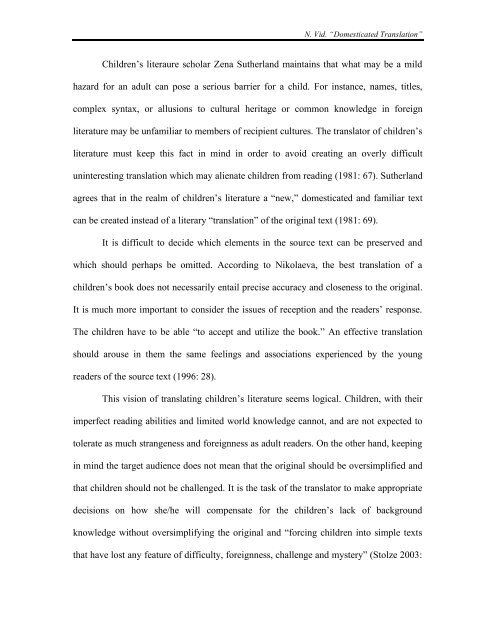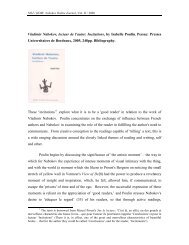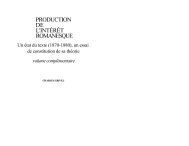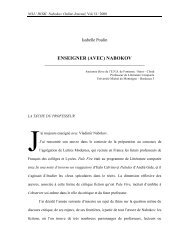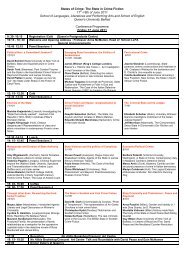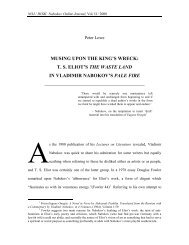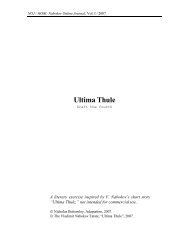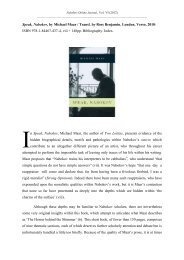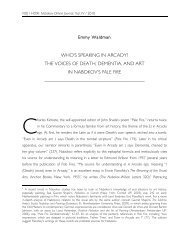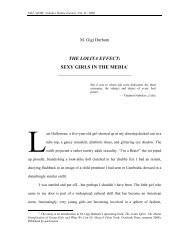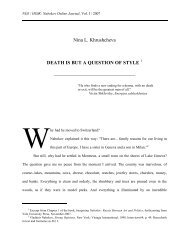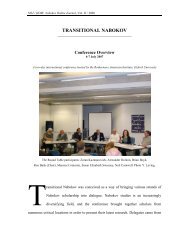domesticated translation: the case of nabokov's translation of alice's
domesticated translation: the case of nabokov's translation of alice's
domesticated translation: the case of nabokov's translation of alice's
You also want an ePaper? Increase the reach of your titles
YUMPU automatically turns print PDFs into web optimized ePapers that Google loves.
N. Vid. “Domesticated Translation”<br />
Children’s literaure scholar Zena Su<strong>the</strong>rland maintains that what may be a mild<br />
hazard for an adult can pose a serious barrier for a child. For instance, names, titles,<br />
complex syntax, or allusions to cultural heritage or common knowledge in foreign<br />
literature may be unfamiliar to members <strong>of</strong> recipient cultures. The translator <strong>of</strong> children’s<br />
literature must keep this fact in mind in order to avoid creating an overly difficult<br />
uninteresting <strong>translation</strong> which may alienate children from reading (1981: 67). Su<strong>the</strong>rland<br />
agrees that in <strong>the</strong> realm <strong>of</strong> children’s literature a “new,” <strong>domesticated</strong> and familiar text<br />
can be created instead <strong>of</strong> a literary “<strong>translation</strong>” <strong>of</strong> <strong>the</strong> original text (1981: 69).<br />
It is difficult to decide which elements in <strong>the</strong> source text can be preserved and<br />
which should perhaps be omitted. According to Nikolaeva, <strong>the</strong> best <strong>translation</strong> <strong>of</strong> a<br />
children’s book does not necessarily entail precise accuracy and closeness to <strong>the</strong> original.<br />
It is much more important to consider <strong>the</strong> issues <strong>of</strong> reception and <strong>the</strong> readers’ response.<br />
The children have to be able “to accept and utilize <strong>the</strong> book.” An effective <strong>translation</strong><br />
should arouse in <strong>the</strong>m <strong>the</strong> same feelings and associations experienced by <strong>the</strong> young<br />
readers <strong>of</strong> <strong>the</strong> source text (1996: 28).<br />
This vision <strong>of</strong> translating children’s literature seems logical. Children, with <strong>the</strong>ir<br />
imperfect reading abilities and limited world knowledge cannot, and are not expected to<br />
tolerate as much strangeness and foreignness as adult readers. On <strong>the</strong> o<strong>the</strong>r hand, keeping<br />
in mind <strong>the</strong> target audience does not mean that <strong>the</strong> original should be oversimplified and<br />
that children should not be challenged. It is <strong>the</strong> task <strong>of</strong> <strong>the</strong> translator to make appropriate<br />
decisions on how she/he will compensate for <strong>the</strong> children’s lack <strong>of</strong> background<br />
knowledge without oversimplifying <strong>the</strong> original and “forcing children into simple texts<br />
that have lost any feature <strong>of</strong> difficulty, foreignness, challenge and mystery” (Stolze 2003:


